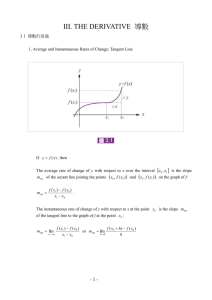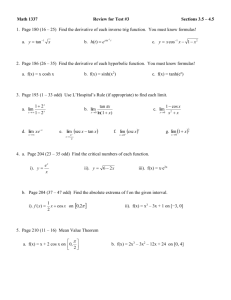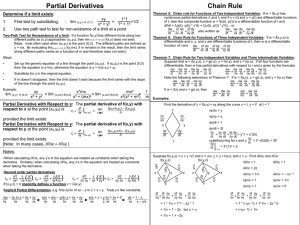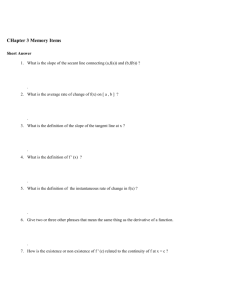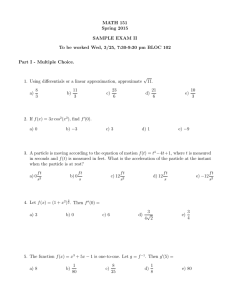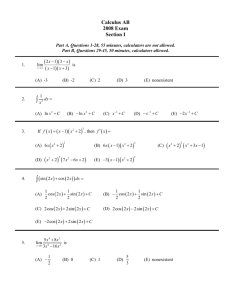1982 AP Calculus AB
advertisement
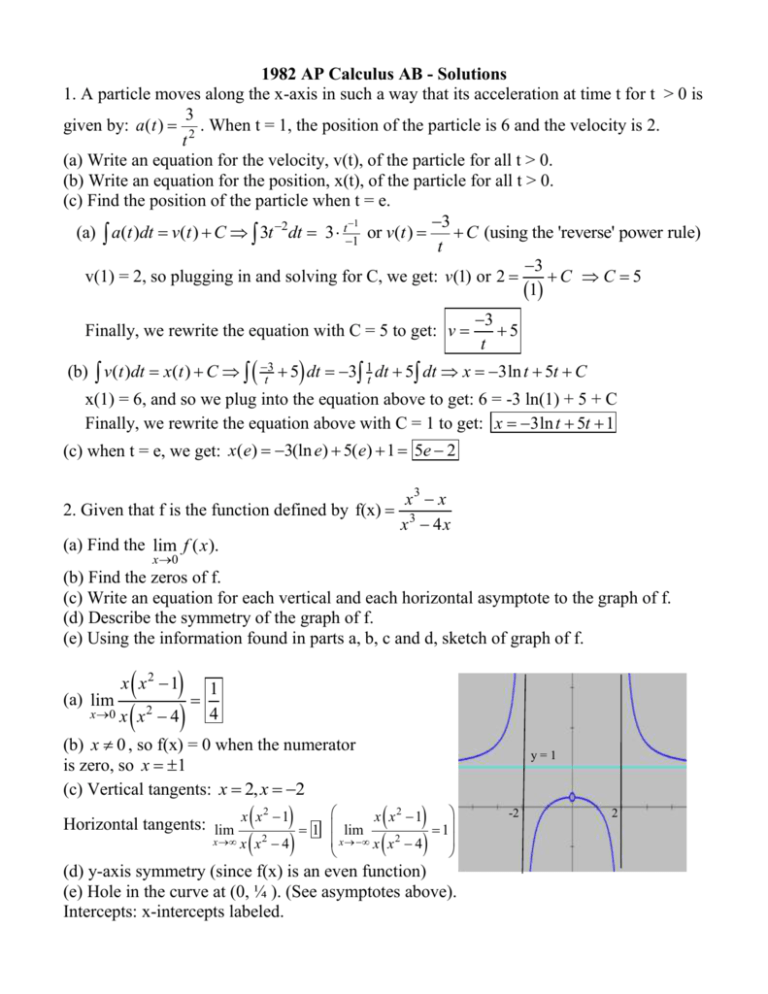
1982 AP Calculus AB - Solutions 1. A particle moves along the x-axis in such a way that its acceleration at time t for t > 0 is 3 given by: a ( t ) 2 . When t = 1, the position of the particle is 6 and the velocity is 2. t (a) Write an equation for the velocity, v(t), of the particle for all t > 0. (b) Write an equation for the position, x(t), of the particle for all t > 0. (c) Find the position of the particle when t = e. 1 3 (a) a(t )dt v(t ) C 3t 2dt 3 t1 or v(t ) C (using the 'reverse' power rule) t 3 C C 5 v(1) = 2, so plugging in and solving for C, we get: v (1) or 2 1 Finally, we rewrite the equation with C = 5 to get: v 3 5 t (b) v(t )dt x(t ) C t3 5 dt 3 1t dt 5 dt x 3ln t 5t C x(1) = 6, and so we plug into the equation above to get: 6 = -3 ln(1) + 5 + C Finally, we rewrite the equation above with C = 1 to get: x 3ln t 5t 1 (c) when t = e, we get: x( e) 3(ln e) 5( e) 1 5e 2 x3 x 2. Given that f is the function defined by f(x) 3 x 4x (a) Find the lim f ( x ). x 0 (b) Find the zeros of f. (c) Write an equation for each vertical and each horizontal asymptote to the graph of f. (d) Describe the symmetry of the graph of f. (e) Using the information found in parts a, b, c and d, sketch of graph of f. xx 1 4 4 x x2 1 (a) lim x 0 2 (b) x 0 , so f(x) = 0 when the numerator is zero, so x 1 (c) Vertical tangents: x 2, x 2 y=1 2 2 Horizontal tangents: lim x x 1 1 lim x x 1 1 2 2 x x x 4 x x x 4 (d) y-axis symmetry (since f(x) is an even function) (e) Hole in the curve at (0, ¼ ). (See asymptotes above). Intercepts: x-intercepts labeled. -2 2 1982 AB – Solutions 3. Let R be the region in the first quadrant that is enclosed by the graph of y = tan(x), the x-axis, and the line x 3 . (a) Find the area of R. (b) Find the volume of the solid formed by revolving R about the x-axis. (a) ln A 3 3 tan x dx 0 0 cos 3 sin x dx cos x ln cos x 3 0 ln cos0 ln 12 ln1 ln 12 or ln2 (b) Disk Method (solid, no hole!): V 3 tan 0 2 x dx sec2 x 1 dx tan x x 0 3 tan 3 3 tan0 0 3 3 2 4. A ladder 15 feet long is leaning against a building so that the end X is on level ground and end Y is on the wall. X is moved away from the building at the constant rate of ½ ft/s. (a) Find the rate of in feet per second at which the length OY is changing when X is 9 feet from the corner of the wall and the ground (point O). (b) Find the rate of change in the area of the triangle XOY when X is 9 ft from the building. The key to the ladder problem is noting that here: dx/dt > 0 but that dy/dt < 0 (negative!) By the Pythagorean Theorem: x 2 y 2 152 Then using implicit differentiation w.r.t. time: dy dy 2 x dx 2 y dt 0 9 12 12 dt 0 dt (a) dy dt 9 ft/s or 3 ft/s 24 8 (b) A 12 bh 12 xy . Now this is tricky. Rather than substitute for y which would be a mess! Use implicit differentiation with the product rule! Another way is to substitute for y, dA dt 9 12 1 12 x dt y dx 12 9 24 dt 2 using y 152 x 2 and then the product rule. dy 2 21 ft s 16 1982 AB – Solutions 5. Let f be the function defined by f ( x ) x 2 1 e x for 4 x 4. (a) For what value of x does f reach its absolute maximum? Justify your answer. (b) Find the x-coordinates of all points of inflection of f . Justify your answer. f ' x 2 1 e x 1 e x 2 x e x x 2 1 2 x e x x 2 2 x 1 e x x 1 2 See how nicely it factors! Before the days of calculator problems! dy 0 e x ( x 1)2 x 1 dx Justify with the 1st derivative test (number line test). Notice the leading negative sign. y decr decr y' - (a) Wait! y is decreasing until x = 1 and then decreases again! There is no maximum point. (b) f '' e x 2 x 11 x 1 e x ( 1) e x x 1 2 x 1 More factoring! 2 d2y dx 2 concave up + y '' e x x 1 3 x 0 x 1 or x 3 down up – + x=1 x=3 Hence, I-pts at x = 1 and x = 3. 6. A tank with a rectangular base and rectangular sides is to be open at the top. It is to be constructed so that its width is 4 meters and volume is 36 m3. If building the tank costs $10/m2 for the base and $5/m2 for the sides, what is the cost of the least expensive tank? Okay, ignore the ‘flaps’! I really liked this box picture… Let y be the height and x be the length of the base. V = 36 = 4xy Cost, C = 10(4x) + 5(4y + 4y + xy + xy) = 40x + 40y + 10xy Replace y with 9x to get C in terms of ‘x’: y 4m x C 40 x 40 9x 10 x 9x 40 x 360 x 1 90 dC dx 2 40 360 x 2 0 40 360 2 x 9 x 3 x x > 0 so consider only x = 3 meters. C decr incr C' – + From the 1st derivative number line, we have minimum cost when x = 3 meters, since dC/dx goes from negative to positive. minC = 120 + 120 + 90 = $330 1982 AB Calculus - Solutions 7. For all real numbers x, f is a differentiable function such that f ( x ) f ( x ). Let f ( p) 1 and f '( p) 5 for some p 0. (a) Find f '( p ). (b) Find f '(0) . (c) Let 1 and 2 be tangent lines at p,1 and p,1 . If 1 and 2 intersect at point Q, find the x- and y-coordinates of Q in terms of p . First of all, notice that f(x) is an even function with y-axis symmetry. Second… (a) looks too easy? Can they really mean the derivative at that ‘p’? Didn’t they just tell us that f '( p ) 5 ??? I kept looking around for f(x) and I do know that if f(x) is even then its derivative is odd (where it’s defined)… I’m going with 5 , ‘final answer’! (b) I feel better about this question. Because of the y-axis symmetry and because the function is everywhere differentiable (unlike the even y = |x| function which is not differentiable at x = 0), we must have dy/dx = 0 at x = 0 (at the y-intercept). f '(0) 0 (c) Since f '( x ) is odd, f '( x ) f '( x ) , so f '( p) f '( p) 5 . Then using the point-slope form for a line: 1 : y 1 5( x p ) and 2 : y 1 5 x p Solving we get: 5( x p ) 5 x p x p x p 0 2 x so x = 0 regardless of p. Then using: y – 1 = 5 (x – p) we get: y – 1 = –5p, so y = –5p + 1 and Q = 0, 5 p 1




